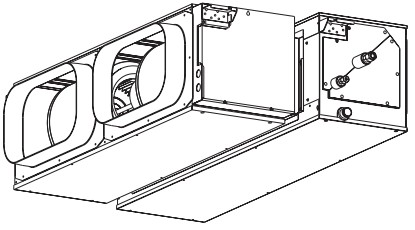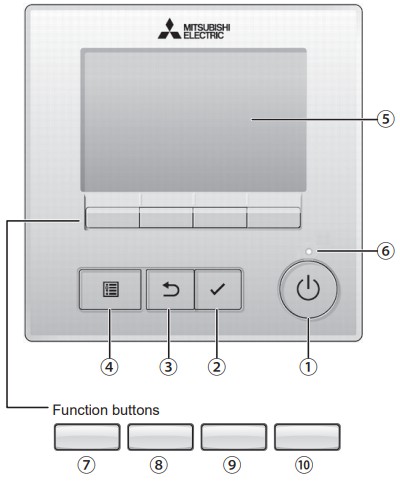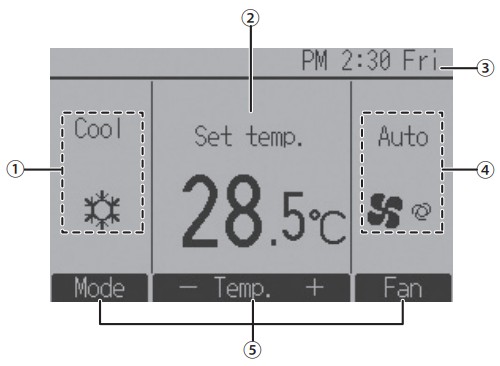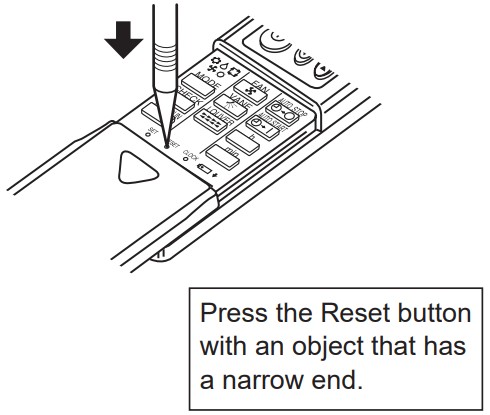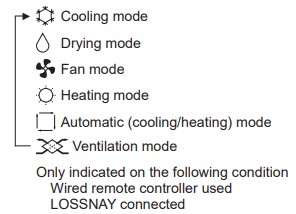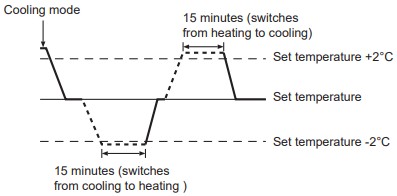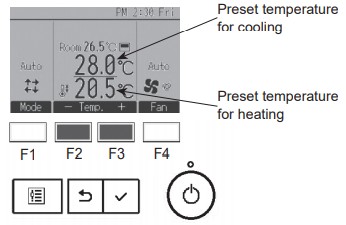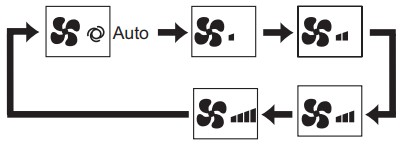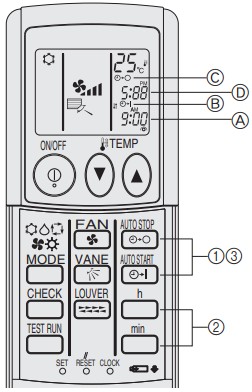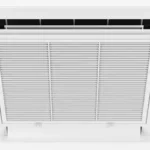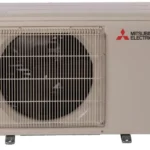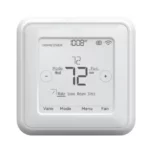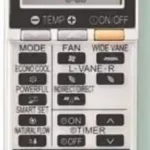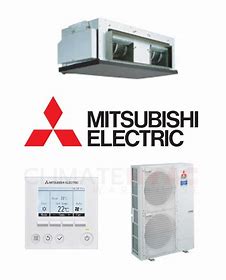
Air-Conditioners
PEA-M100, 125, 140HAA
OPERATION MANUAL
For safe and correct use, please read this operation manual thoroughly before operating the air-conditioner unit.
Note:
The phrase “Wired remote controller” in this operation manual refers only to the PAR-40MAA. If you need any information for another remote controller, please refer to the instruction book included with the remote controller.
Safety Precautions
►Before operating the unit, make sure you read all the “Safety precautions”.
► “Safety precautions” lists important points about safety. Please be sure to follow them.
MEANINGS OF SYMBOLS ON THE UNIT
 |
WARNING
(Risk of fire) |
This symbol is only for R32 refrigerants. The type of refrigerant used is written on the nameplate on the outdoor unit. R32 refrigerant is flammable. If the refrigerant leaks, or comes in contact with fire or parts that generate heat, it may create harmful gas and pose a risk of fire. |
 |
Read the OPERATION MANUAL carefully before operation. | |
 |
Service personnel is required to carefully read the OPERATION MANUAL and INSTALLATION MANUAL before operation. | |
 |
Further information is available in the OPERATION MANUAL, INSTALLATION MANUAL, and the like. | |
Symbols used in the text

Describes precautions that should be observed to avoid the risk of injury or death to the user.

Describes precautions that should be observed to prevent damage to the unit.
Symbols used in the illustrations

Carefully read the labels affixed to the main unit.

These appliances are not accessible to the general public.
The unit must not be installed by the user. Ask the dealer or an authorized company to install the unit. If the unit is installed improperly, water leakage, electric shock, or fire may result.
Do not stand on, or place any items on the unit.
This air conditioner is NOT intended for use by children or infirm persons without supervision.
Young children must be supervised to ensure that they do not play with the air conditioner.
When installing, relocating, or servicing the air conditioner, use only the specified refrigerant written on the outdoor unit to charge the refrigerant lines. Do not mix the refrigerant with any other refrigerant, and do not allow air to remain in the lines.
– If air is mixed with the refrigerant, then it may cause abnormally high pressure in the refrigerant lines, resulting in an explosion and other hazards.
– The use of any refrigerant other than that specified for the system will cause mechanical failure, system malfunction, or unit breakdown. In the worst case, this could lead to a serious impediment to securing product safety.
– It may also be in violation of applicable laws.
– MITSUBISHI ELECTRIC CORPORATION cannot be held responsible for malfunctions or accidents resulting from the use of the wrong type of refrigerant.
- This indoor unit should be installed in a room that is equal to or larger than the floor space specified in the outdoor unit installation manual. Refer to the outdoor unit installation manual.
- Only use means recommended by the manufacturer to accelerate the defrosting process or to clean.
- This indoor unit shall be stored in a room that has no continuously operating ignition devices such as open flame, gas appliance, or electrical heater.
- Do not pierce a hole in or burn this indoor unit or refrigerant lines.
- Be aware that the refrigerant may be odor-free.
- Do not splash water over the unit and do not touch the unit with wet hands. An electric shock may result.
- Do not spray combustible gas close to the unit. Fire may result.
- Do not place a gas heater or any other open-flame appliance where it will be exposed to the air discharged from the unit.
Incomplete combustion may result. - Do not remove the front panel or the fan guard from the outdoor unit when it is running. You could be injured if you touch rotating, hot or high-voltage parts.
- Never insert fingers, sticks, etc. into the intakes or outlets, otherwise, an injury may result since the fan inside the unit rotates at high speed. Exercise particular care when children are present.
- If you detect odd smells, stop using the unit, turn off the power switch and consult your dealer. Otherwise, a breakdown, electric shock, or fire may result.
- When you notice exceptionally abnormal noise or vibration, stop the operation, turn off the power switch and contact your dealer.
- Do not over-cool. The most suitable inside temperature is one that is within 5°C of the outside temperature.
- Do not leave handicapped people or infants sitting or standing in the path of the airflow from the air-conditioner. This could cause health problems.

- Do not use any sharp object to push the buttons, as this may damage the remote controller.
- Do not twist or tug on the remote controller cord as this may damage the remote controller and cause malfunction.
- Never remove the upper case of the remote controller. It is dangerous to remove the upper case of the remote controller and touch the printed circuit boards inside. Doing so can result in fire and failure.
- Never wipe the remote controller with benzene, thinner, chemical rags, etc. Doing so can result in discoloration and failure. To remove heavy stains, soak a cloth in neutral detergent mixed with water, wring it out thoroughly, wipe the stains off, and wipe again with a dry cloth.
In case of failure

- Never remodel the air conditioner. Consult your dealer for any repair service. Improper repair work can result in water leakage, electric shock, fire, etc.
- If the remote controller displays an error indication, the air conditioner does not run, or there is any abnormality, stop operation and contact your dealer. Leaving the unit as it is under such conditions can result in fire or failure.
- If the power breaker is frequently activated, get in touch with your dealer. Leaving it as it is can result in fire or failure.
- If the refrigeration gas blows out or leaks, stop the operation of the air conditioner, thoroughly ventilate the room, and contact your dealer. Leaving the unit as it is can result in accidents due to oxygen deficiency.
Disposing of the unit

When you need to dispose of the unit, consult your dealer. If pipes are removed incorrectly, refrigerant (fluorocarbon gas) may blow out and come into contact with your skin, causing injury. Releasing refrigerants into the atmosphere also damages the environment.
- Never block or cover the indoor or outdoor unit’s intakes or outlets. Tall items of furniture underneath the indoor unit, or bulky items such as large boxes placed close to the outdoor unit will reduce the unit’s efficiency.
- Do not direct the airflow at plants or caged pets.
- Ventilate the room frequently. If the unit is operated continuously in a closed room for a long period of time, the air will become stale.
When the air conditioner is not to be used for a long time
- If the air conditioner is not to be used for a long time due to a seasonal change, etc., run it for 4 – 5 hours with the air blowing until the inside is completely dry. Failing to do so can result in the growth of unhygienic, unhealthy mold in scattered areas throughout the room.
- When it is not to be used for an extended time, keep the [power supply] turned OFF.
If the power supply is kept on, several watts or several tens of watts will be wasted. Also, the accumulation of dust, etc., can result in fire. - Keep the power switched ON for more than 12 hours before starting operation. Do not turn the power supply OFF during seasons of heavy use. Doing so can result in failure.
Parts Names
■ Indoor Unit
| PEA-M·HAA | |
| Fan steps | 4 steps |
| Vane | – |
| Louver | – |
| Filter | – |
| Filter cleaning indication | – |
■ PEA-M·HAA
Ceiling Concealed
■ Wired Remote Controller
Controller interface
- When the backlight is off, pressing any button turns the backlight on
and does not perform its function. (except for the ON/OFF button)
The functions of the function buttons change depending on the screen. Refer to the button function guide that appears at the bottom of the LCD for the functions they serve on a given screen.
When the system is centrally controlled, the button function guide that corresponds to the locked button will not appear.
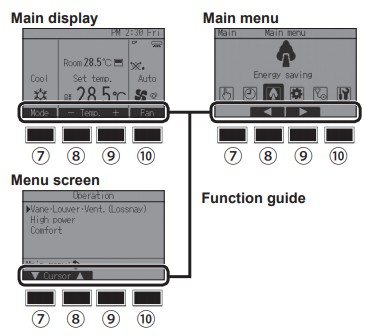
① ON/OFF button
Press to turn ON/OFF the indoor unit.
② SELECT button
Press to save the setting.
③ RETURN button
Press to return to the previous screen.
④ MENU button
Press to bring up the Main menu.
⑤ Backlit LCD
Operation settings will appear.
When the backlight is off, pressing any button turns the backlight on and it will stay lit for a certain period of time depending on the screen.
⑥ ON/OFF lamp
This lamp lights up in green while the unit is in operation. It blinks while the remote controller is starting up or when there is an error.
⑦ Function button F1
Main display: Press to change the operation mode.
Menu screen: The button function varies with the screen.
⑧ Function button F2
Main display: Press to decrease temperature.
Main menu: Press to move the cursor left.
Menu screen: The button function varies with the screen.
⑨ Function button F3
Main display: Press to increase temperature.
Main menu: Press to move the cursor right.
Menu screen: The button function varies with the screen.
⑩ Function button F4
Main display: Press to change the fan speed.
Menu screen: The button function varies with the screen.
Display
The main display can be displayed in two different modes: “Full” and “Basic.”
The factory setting is “Full.”
<Full mode>
<Basic mode>
① Operation mode
Indoor unit operation mode appears here.
② Preset temperature
Preset temperature appears here.
③ Clock
The current time appears here.
④ Fan speed
Fan speed setting appears here.
⑤ Button function guide
Functions of the corresponding buttons appear here.
⑥
Appears when the ON/OFF operation is centrally controlled.
⑦
Appears when the operation mode is centrally controlled.
⑧
Appears when the preset temperature is centrally controlled.
⑨
Appears when the filter reset function is centrally controlled.
⑩
Indicates when the filter needs maintenance.
⑪ Room temperature
The current room temperature appears here.
⑫
Appears when the buttons are locked.
⑬
Appears when the On/Off timer, Night setback, or Auto-off timer function is enabled.
appears when the timer is disabled by the centralized control system.
⑭
Appears when the Weekly timer is enabled.
⑮
Appears while the units are operated in the energy-save mode.
⑯
Appears while the outdoor units are operated in the silent mode.
⑰
Appears when the built-in thermistor on the remote controller is activated to monitor the room temperature (⑪ ).

⑱
Appears when the preset temperature range is restricted.
⑲
Appears when an energy-saving operation is performed using a “3D i-See sensor” function.
■ Wireless Remote-Controller (option)
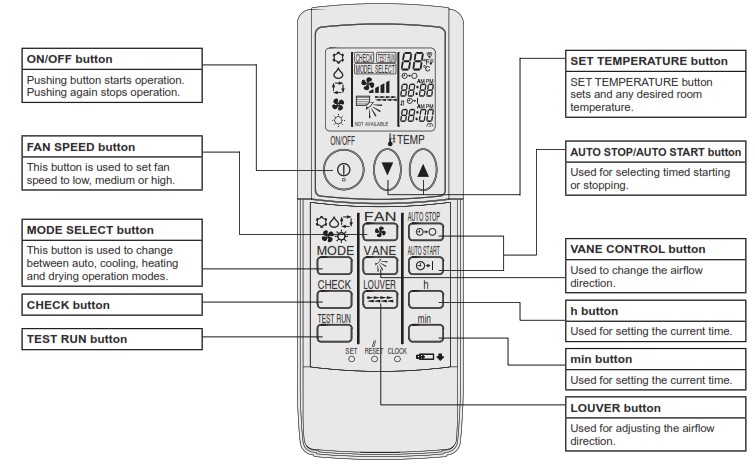
■ When using the wireless remote controller, point it towards the receiver on the indoor unit.
■ If the remote controller is operated within approximately two minutes after power is supplied to the indoor unit, the indoor unit may beep twice as the unit is performing the initial automatic check.
■ The indoor unit beeps to confirm that the signal transmitted from the remote controller has been received. Signals can be received up to approximately 7 meters in a direct line from the indoor unit in an area 45° to the left and right of the unit. However, illumination such as fluorescent lights and strong light can affect the ability of the indoor unit to receive signals.
■ If the operation lamp near the receiver on the indoor unit is flashing, the unit needs to be inspected. Consult your dealer for service.
■ Handle the remote controller carefully! Do not drop the remote controller or subject it to strong shocks. In addition, do not get the remote controller wet or leave it in a location with high humidity.
■ To avoid misplacing the remote controller, install the holder included with the remote controller on a wall, and be sure to always place the remote controller in the holder after use.
Battery installation/replacement
- Remove the top cover, insert two AAA batteries, and then install the top cover.
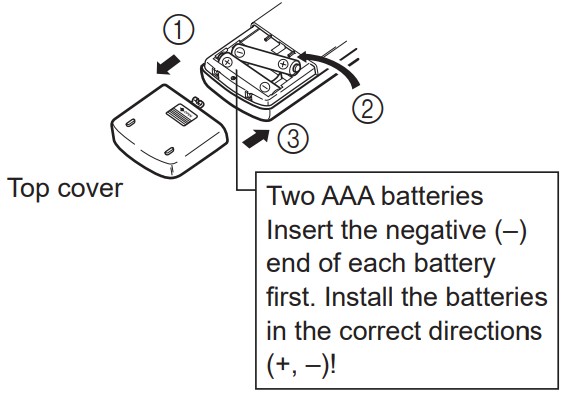
- Press the Reset button.
Operation
■ About the operation method, refer to the operation manual that comes with each remote controller.
Mode select
For wired remote controller
*1 Operation modes that are not available to the connected indoor unit models will not appear on the display.
*2 Single or dual setpoints will appear, depending on the indoor unit model.
* Interlocked operation is performed in all the operation modes when the ventilation unit is interlocked.
What the blinking mode icon means
The mode icon will blink when other indoor units in the same refrigerant system (connected to the same outdoor unit) are already operated in a different mode. In this case, the rest of the unit in the same group can
only be operated in the same mode.
For wireless remote controller
■ Press the operation mode
Automatic operation
■ According to a set temperature, the cooling operation starts if the room temperature is too hot and heating operation starts if the room temperature is too cold.
■ During automatic operation, if the room temperature changes and remains 2 °C or more above the set temperature for 15 minutes, the air conditioner switches to cooling mode. In the same way, if the room
temperature remains 2 °C or more below the set temperature for 15 minutes, the air conditioner switches to heating mode.
■ Because the room temperature is automatically adjusted in order to maintain a fixed effective temperature, a cooling operation is performed a few degrees warmer, and a heating operation is performed a few degrees cooler than the set room temperature once the temperature is reached (automatic energy-saving operation).
Preset temperature setting
For wired remote controller
Preset temperature will be displayed either in Celsius in 0.5- or 1-degree increments, or in Fahrenheit, depending on the indoor unit model and the display mode setting on the remote controller.
<Cool, Dry, Heat, and Auto (single set point)>
Press button ⑧ [F2] to decrease the preset temperature.
Press button ⑨ [F3] to increase the preset temperature.
<Auto (dual set point)>
- Press button ⑧ [F2] or ⑨ [F3].
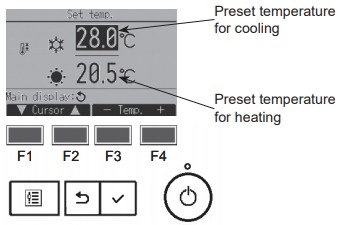
- Press button ⑦ [F1] or button ⑧ [F2] to move the cursor to the desired temperature setting (cooling or heating).
Press button ⑨ [F3] to decrease the selected temperature, and ⑩ [F4] to increase.
For wireless remote controller
► To decrease the room temperature:
Press 
The selected temperature is displayed 3.
• Each time you press the button, the temperature value decreases by 1 °C.
► To increase the room temperature:
Press
The selected temperature is displayed 3.
- Each time you press the button, the temperature value decreases by 1 °C.
- Available temperature ranges are as follows:
Cooling/Drying: 19 – 30 °C
Heating: 17 – 28 °C
Automatic: 19 – 28 °C - The display flashes either 8 °C – 39 °C to inform you if the room temperature is lower or higher than the displayed temperature.
Fan speed setting
For wired remote controller
Press button ⑩ [F4] to go through the fan speed.
* The number of available fan speeds depends on the model.
Notes:
The actual fan speed will be different from the fan speed displayed
on the LCD when one of the following conditions is met.
- While “Standby” or “Defrost” is displayed
- When the room temperature is higher than the preset temperature during the heating mode
- Right after the heating operation (during stand by for switching the operation mode)
- During the dry mode
For wireless remote controller
■ Press
- Each time you press the button, available options change with the display 4 on the remote controller, as shown below.
Notes:
- In the following cases, the actual fan speed generated by the unit will differ from the speed shown the remote controller display.
- While the display is in “STAND BY” or “DEFROST” states.
- When the temperature of the heat exchanger is low in the heating mode.
(e.g. immediately after heating operation starts) - In HEAT mode, when room temperature is higher than the temperature setting.
- When the unit is in DRY mode.
■ Timer functions are different by each remote controller.
■ For details on how to operate the remote controller, refer to the appropriate operation manual included with each remote controller.
4.1. For wireless remote controller (option)
1) Set the current time
1) Press the CLOCK button using a thin stick and blink the time A.
2 )Press the 

3) Press the CLOCK button using a thin stick.
2) Set the time to start the unit as follows
1 Press the 
- Time can be set while the following symbol is blinking.
On-time: B START is blinking. - The start times are displayed at A.
2) Use the

3) To cancel the ON timer, press the
3) Set the time to stop the unit as follows
1 Press the
- Time can be set while the following symbol is blinking.
Off time: C STOP is blinking. - The stop times are displayed at D.
2 )Use the

3 )To cancel the OFF timer, press the button.
4) Changing the set times
Press the
Emergency Operation for Wireless Remote-controller (option)
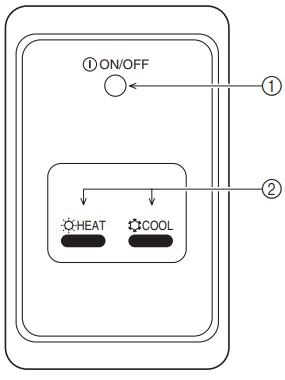
- ON/OFF lamp (lit when the unit is operating; unlit when the unit is not operating)
- Emergency operation
In cases where the remote control unit does not operate properly, use either the


Pressing the

| Operation mode | COOL | HEAT |
| Preset temperature | 24 °C/75 °F | 24 °C/75 °F |
| Fan speed | High | High |
Trouble Shooting
| Having trouble? | Here is the solution. (Unit is operating normally.) |
| Noise is louder than specifications. | The indoor operation sound level is affected by the acoustics of the particular room as shown in the following table and will be higher than the noise specification, which was measured in an echo-free room. |
| Nothing appears in the wireless remote controller display, the display is faint, or signals are not received by the indoor unit unless the remote controller is close. | The batteries are low. Replace the batteries and press the Reset button.If nothing appears even after the batteries are replaced, make sure that the batteries are installed in the correct directions (+, –). |
| The operation lamp near the receiver for the wireless remote controller on the indoor unit is flashing. | The self diagnosis function has operated to protect the air conditioner.
Do not attempt to repair this equipment by yourself. |
| Item | Model | PEA-M100HAA | PEA-M125HAA | PEA-M140HAA | ||
| Dimension | Height / Width / Depth | mm | 380/1405/900 | |||
| Net weight | kg | 63 | 66 | 66 | ||
|
Fan |
Airflow rate
(Low-Mid1-Mid2-High) |
50Pa | m3/min | 30-34-38-42 | 42-48-54-60 | 42-48-54-60 |
| 100Pa | m3/min | 30-34-38-42 | 42-48-54-60 | 42-48-54-60 | ||
| 150Pa | m3/min | 30-34-38-42 | 42-48-54-58 | 42-48-54-58 | ||
| External static pressure | Pa | 50/100/150 | ||||
| Sound pressure level (Low-Mid1-Mid2-High) | 50Pa | dB(A) | 29-32-36-38 | 35-38-42-45 | 35-38-42-45 | |
| 100Pa | dB(A) | 33-36-39-42 | 36-40-43-46 | 36-40-43-46 | ||
| 150Pa | dB(A) | 36-39-42-45 | 39-43-46-48 | 39-43-46-48 | ||
Please be sure to put the contact address/telephone number on this manual before handing it to the customer.
MITSUBISHI ELECTRIC CORPORATION
HEAD OFFICE: TOKYO BLDG., 2-7-3, MARUNOUCHI, CHIYODA-KU, TOKYO 100-8310, JAPAN
VG79D916H02



